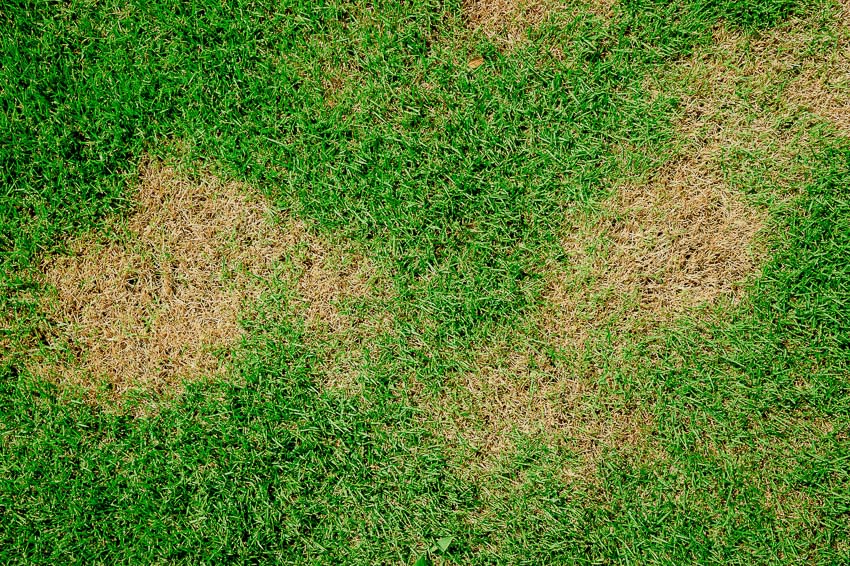Do you have unsightly brown patches on your beautiful green lawn? Ugly brown patches are often caused by brown patch grass fungus. Discover the common causes of brown patches in your grass and find the best brown patch grass treatments for your lawn.
What Causes Brown Patch Grass?
Your lush green lawn suddenly has patches of brown, dead grass, and you’re not sure what the cause is.
The problem could be brown patch fungus, or it could be one of the various other causes of brown patches on grass. Fortunately, there are simple cures for the causes of brown patches on your lawn.
What is Brown Patch Fungus?
If patches of your lawn start to turn yellow after hot, humid weather, it could be brown patch fungus (Rhizoctonia solani). Brown patch lawn disease thrives in moist conditions and will often present itself after periods of prolonged moisture.
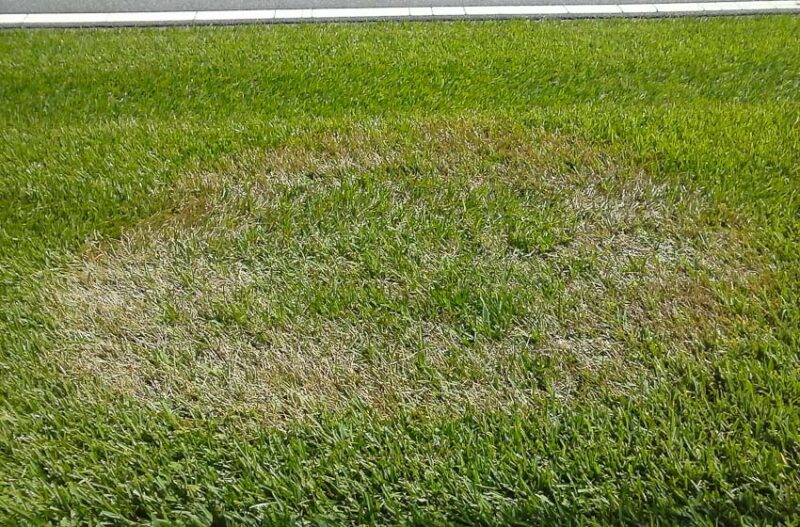
Brown patch fungus, also called large patch disease, affects different types of lawn grass–warm and cool-season–when they are weakest. This fungus affects warm-season grasses like Bermuda grass and zoysia grass in the spring. That’s when they emerge from dormancy.
Meanwhile, cool-season grasses have fungus problems during the summer.
Signs of Brown Patch Grass Fungus
There are many reasons for brown patches of dead grass. Even though there are simple cures for each problem, a cure for one can worsen another issue.
Therefore, it’s important to recognize the signs of brown patch fungus in your grass and apply the proper treatment before it wreaks havoc on your beautiful lawn.
Here’s what to look for:
- Circular light green patches from 2 inches up to 2 feet
- Round patches of brown grass in your lawn
- The outer edges of patches are a smoky brown or gray
- Wilting or yellowing blades of grass
- Brown or red leaf tips on grass blades
- Spotting on blades of grass
- Irregularly shaped patches of dead grass
Patches of brown patch fungus can grow to as large as 20 feet in diameter, spreading mostly in the parts of your lawn that are consistently moist, such as shady and low areas.
Other Causes of Brown Spots on Your Lawn
What causes brown patches in your grass? Your lawn can turn brown for many reasons, and it helps to know the cause before you jump to conclusions. Learn more about the causes of brown grass patches before treating a fungal infection.
Lawn Grubs
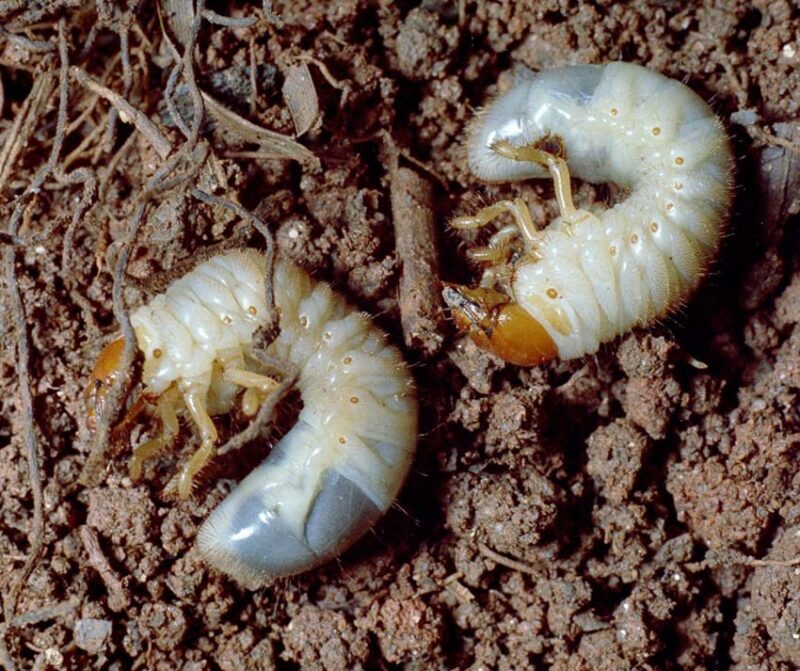
You should definitely get rid of grubs, which can decimate the root zones of your lawn and cause it to turn brown and die. Thankfully, monitoring your lawn for grub infections is easy.
Dig a few square-foot patches and count how many grubs are in each area. More than 10 grubs per square foot indicate an infestation of grubs.
Once they pupate, they will emerge as adult beetles.
Some types of beetles, including Japanese beetles, can cause significant amounts of damage to your plants and trees. Another problem you may have is animals like raccoons, skunks, and moles digging up your yard in search of grubs.
Pet Urine
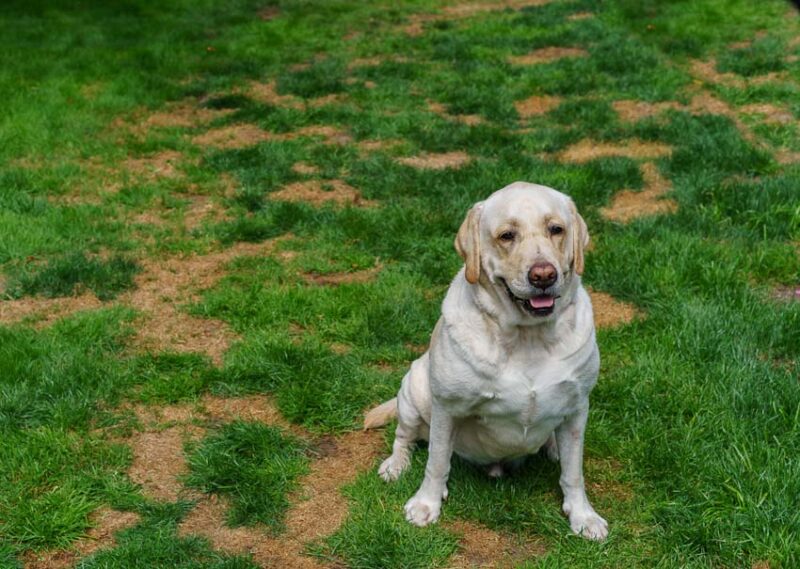
Dogs are the most common cause of pet urine burns on lawns. If they use the same area every day, it’s likely to cause dead patches in your grass.
You can treat pet urine burns on your lawn by rinsing them thoroughly with water, removing the dead vegetation, and planting new grass seed.
Consider dog-friendly landscaping ideas to avoid the problem altogether, such as gravel runs or artificial grass pet yards.
Heavy Thatch
Thatch is the layer of dead grass and organic matter on top of the soil, and it can cause several problems.
Heavy thatch doesn’t allow water to drain into the root zone. If your lawn needs dethatching, you may have noticed water running off onto sidewalks and driveways while watering.
A thick layer of thatch will effectively smother your lawn, preventing it from getting water, air, and nutrients. That can result in patches of dead grass.
Test the thatch buildup by digging into your lawn and taking a cross-section of soil and turf. If the thatch build-up is over a half inch, it’s time to dethatch your lawn.
Soil Compaction and Erosion
Erosion happens on a small scale in your yard all the time. It’s a natural process where forces like water and wind move soil particles, and it’s a common cause of dead patches of grass on slopes.
Soil compaction happens naturally due to heavy rains, but foot and vehicular traffic can also worsen it. When soil gets compacted, it’s more susceptible to erosion.
You can control erosion and soil compaction in your lawn by aerating it. Consider using a retaining wall with a steep slope, even if your slope is only a few feet.
Poor Soil Quality
Lawns need fertile, well-drained soil and plenty of nutrients for lush green growth. One of the causes of patches of brown grass is poor soil quality.
A soil test can tell you exactly what to add to your soil to revitalize it. Liming your lawn is one of the best ways to make nutrients more available because acidic soils will cause the nutrients to get bound up and become inaccessible to plants.
Overfertilizing
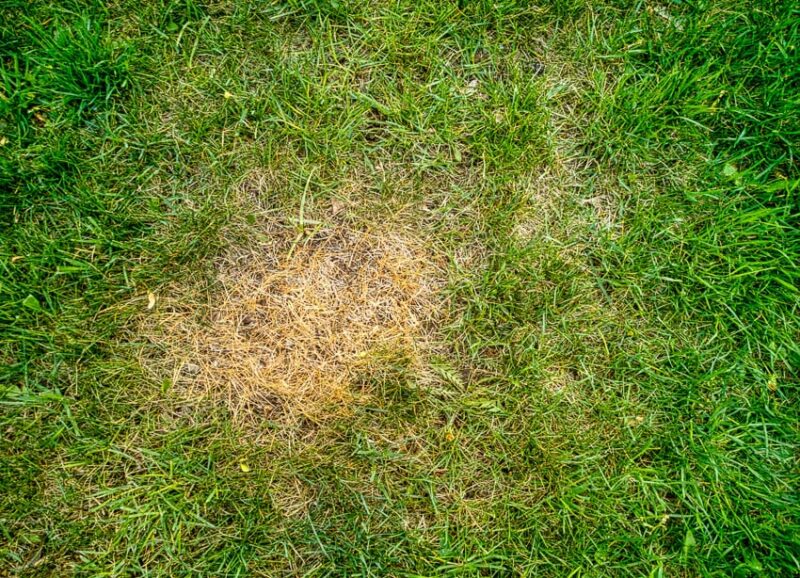
Knowing how and when to fertilize your lawn can be challenging, especially since there are so many different types of fertilizers on the market.
There’s a lot to know about how to fertilize your lawn. If you think over-fertilization is the problem, water your grass thoroughly for several days. Avoid fertilizing during hot, humid weather, and make a plan to stick to a lawn fertilizer schedule in the future.
Dormancy
Grass is naturally designed to go dormant. During extended periods of hot weather in the summer, cool-season grasses will turn brown, while warm-season grasses go dormant in the winter.
As long as you have a healthy lawn with fertile, well-drained soil, and you’re choosing the best type of grass for your region, there’s little else you can do about seasonal dormancy issues.
Effective Treatments for Brown Patch Grass
Brown patch fungus won’t go away on its own, so once you’ve identified it in your lawn, it must be treated. After you get it under control, proper lawn care practices will help prevent it from recurring.
Proper Lawn Care Practices
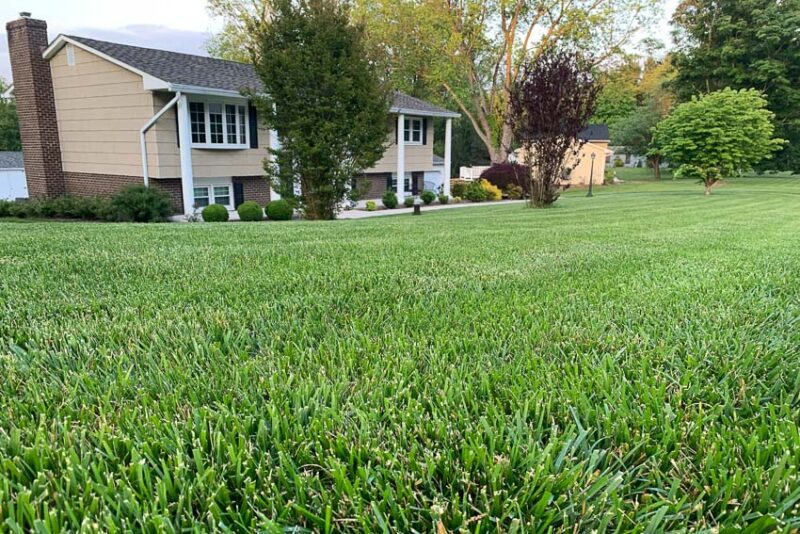
Properly cared for lawns are more resilient and less likely to be infected by brown patch grass diseases. Watering, mowing, and fertilizing are the main lawn chores you must address.
Deep, infrequent watering will give your lawn the moisture it needs without creating a breeding ground for fungus. The best time to water your grass is in the morning so it can dry out during the day.
Cutting your lawn too short can make it susceptible to diseases by weakening the root system. Keep your grass mowed between 2 and 3.5 inches to increase its tolerance to stress.
Before you choose a fertilizer schedule, you should decide whether to use organic or synthetic fertilizers. Organic fertilizers are a good choice because they are slow-release and less likely to burn your lawn.
You should test your soil once per year to maintain optimal soil health, and you may need to add soil amendments or lime your lawn to balance the pH levels.
Fungicide Application
If you’ve had brown patch fungus in the past, consider applying fungicides when temperatures reach 60°F (15°C). Continue application every two to four weeks until conditions are no longer favorable.
Fungicides come in liquid or granular form. Lawn fungicides used to treat brown patch fungus include Azoxystrobin, usually with Propiconazole, Pyraclostrobin with Triticonazole, and Fluoxastrobin.
Since lawn fungus can develop a resistance to chemical treatments, it helps to alternate different types of fungicides.
Improving Air Circulation
Ensuring your lawn has good air circulation and drainage will help prevent lawn diseases like brown patch fungus.
Wet conditions worsen fungal infections, and since many types of fungus are already in your soil, it’s critical to prevent favorable conditions for fungal growth.
As much as possible, reduce the time the blades of your grass are wet. You can improve air circulation in your yard by pruning trees and shrubs and switching from solid to louvered fences that allow airflow.
Aeration and Dethatching
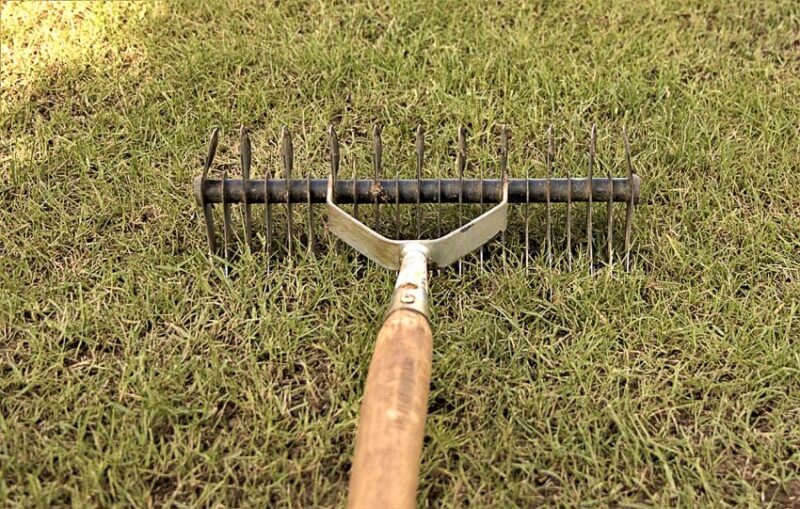
Improving air circulation by aerating and dethatching your lawn is another critical care practice to help you avoid many lawn diseases.
Most lawns need to be aerated about once per year, but some soils are more easily compacted. Heavy clay soils sometimes require twice-annual aeration.
Choose the best type of aerator for your lawn with our guide to core aerators vs. spike aerators.
Dethatching is only required every few years, but if you have heavy buildup, aerating your lawn will be easier if you dethatch it first. It will also improve air circulation near the root zone.
Another idea is to switch to patio pavers or gravel walkways in areas with a lot of foot traffic. Any spots on your lawn compacted due to human or pet foot traffic are vulnerable to lawn diseases.
Importance of Addressing Brown Patch Grass
Finding a treatment for brown patch grass fungus is important for several reasons. Lawn disease can affect your home’s curb appeal and affect the overall health of your lawn.
Lawn Aesthetics and Curb Appeal
One of the most significant benefits of a lush, green lawn is that it adds to your home’s curb appeal, making it seem more inviting and increasing your property value.
When your lawn is infected with brown patch fungus, the unsightly patches of dead grass are an eyesore that impacts the aesthetics of your property.
Lawn Health and Longevity
In some cases, lawns will recover after you treat brown patch grass fungus conditions are no longer favorable for it to spread. It may take a few weeks before the dead spots on your grass recover.
If the damage was severe, you may need to repair your lawn by planting new grass seed or sod.
Impact on Other Plants and Ecosystems
Monocultures like grass lawns are micro-ecosystems susceptible to damage caused by fungal diseases such as brown patch. Because no other plants can step in where you have infected grass, diseased plants leave gaps in lawns that can lead to weed infestations.
Learn how to protect your lawn with our guide on how to get rid of weeds in grass.
If lawn diseases spread to other lawns in the neighborhood, it can cause widespread damage.
Furthermore, diseased lawns can cause other problems like soil erosion. Erosion affects ecosystems when rainwater carries contaminants and soil particles into nearby streams, lakes, and rivers.
FAQ: Common Questions About Brown Patch Grass Treatment
1. Can brown patch grass spread to other lawns?
Brown patch grass can spread by wind, foot traffic, and mowing equipment. Lawn care professionals clean and treat their mowing equipment after cutting lawns infected with fungal diseases like brown patch grass fungus.
2. How quickly will my lawn recover after treatment?
After applying a fungicide, it usually takes lawns about one to two weeks to recover from a fungal infection. However, the damage will take several weeks to reverse, and you may need to renovate patches of your lawn by reseeding or sodding severely affected areas.
3. Is it safe for pets and children to be on the treated lawn?
You should keep pets and children off lawns for at least 72 hours after lawn treatment with a fungicide. Also, be sure to keep concentrated products away from pets and children to avoid accidental poisoning.
4. Can I prevent brown patch grass without using chemicals?
If you want to avoid using harsh chemicals, there are a few effective methods to get rid of brown patch grass fungus naturally. You can apply baking soda can be applied manually or mixed with water and sprayed on your lawn. Vinegar is another natural control, but it’s also a weed killer, so use it cautiously.
5. Should I remove the affected grass patches?
The main reason to remove patches of grass infected by brown patch fungus is so that you can repair the bare spots. Once brown patch fungus kills grass, it will take a few weeks to come back. In the meantime, your lawn will be susceptible to weeds.

